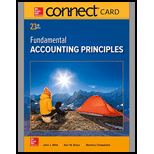
Concept Introduction:
Classification of Investments:
The investments are classified on the basis of the two factors to be considered
1. Intent of the company
2. Length of time for which it will be held.
The three categories for investments are
i. Trading investments (Short-term investment)
The debt and equity securities investments will be classified as trading securities if they are purchased with an intention to be sold in a short time of their purchase. Suppose, 3 months or 4 months i.e. held with an intention to be sold in a short period.
ii. Available-for-sale investments (Long term as well as short term investment)
The debt and equity securities investments will be classified as available-for-sale investments if they are purchased with an intention to be sold in a longer time period say, more than a year. By default all the investments are classified as available-for-sale investments.
iii. Held-to-Maturity (Long term investment)
Held-to-maturity investments are the investments that are purchased with an intention to be held till maturity. When a purchase is made with an intent that it will be held till maturity, it will be classified as held-to-maturity investment.
Thus, short term investments include the investments which can be easily liquidated into the cash and are held with an intention to be sold within a short-term period. All the held-to-maturity investments will be considered as long-term investments.
To classify:
Classification of statements as long-term investments.
Want to see the full answer?
Check out a sample textbook solution
Chapter 15 Solutions
Connect Access Card for Fundamental Accounting Principles
- Please explain the solution to this general accounting problem with accurate principles.arrow_forwardThe following data relate to Stratton Enterprises for the year ending December 31, 2023.arrow_forwardPlease help me solve this financial accounting problem with the correct financial process.arrow_forward
- What is the contribution margin ratio?arrow_forwardZeppelin Construction Company has total assets for the year of $35,600 and total liabilities of $19,800. A) Use the accounting equation to solve for equity. B) If next year's assets increased by $8,400 and equity decreased by $3,750, what would be the amount of total liabilities for Zeppelin Construction Company?arrow_forwardI need help finding the accurate solution to this financial accounting problem with valid methods.arrow_forward

 AccountingAccountingISBN:9781337272094Author:WARREN, Carl S., Reeve, James M., Duchac, Jonathan E.Publisher:Cengage Learning,
AccountingAccountingISBN:9781337272094Author:WARREN, Carl S., Reeve, James M., Duchac, Jonathan E.Publisher:Cengage Learning, Accounting Information SystemsAccountingISBN:9781337619202Author:Hall, James A.Publisher:Cengage Learning,
Accounting Information SystemsAccountingISBN:9781337619202Author:Hall, James A.Publisher:Cengage Learning, Horngren's Cost Accounting: A Managerial Emphasis...AccountingISBN:9780134475585Author:Srikant M. Datar, Madhav V. RajanPublisher:PEARSON
Horngren's Cost Accounting: A Managerial Emphasis...AccountingISBN:9780134475585Author:Srikant M. Datar, Madhav V. RajanPublisher:PEARSON Intermediate AccountingAccountingISBN:9781259722660Author:J. David Spiceland, Mark W. Nelson, Wayne M ThomasPublisher:McGraw-Hill Education
Intermediate AccountingAccountingISBN:9781259722660Author:J. David Spiceland, Mark W. Nelson, Wayne M ThomasPublisher:McGraw-Hill Education Financial and Managerial AccountingAccountingISBN:9781259726705Author:John J Wild, Ken W. Shaw, Barbara Chiappetta Fundamental Accounting PrinciplesPublisher:McGraw-Hill Education
Financial and Managerial AccountingAccountingISBN:9781259726705Author:John J Wild, Ken W. Shaw, Barbara Chiappetta Fundamental Accounting PrinciplesPublisher:McGraw-Hill Education





